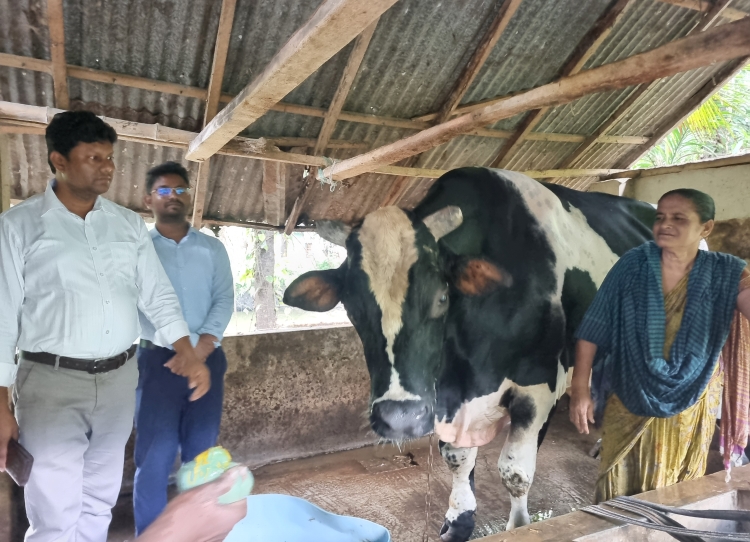News Flash

KHULNA, May 25, 2025 (BSS) - With Eid-ul-Azha approaching, cattle farmers in Dumuria upazila of Khulna are busy preparing sacrificial animals using traditional and organic methods, hoping for good profits this year.
With strong demand expected during the upcoming festival, farmers are optimistic about better profits this year, provided the market remains stable. The use of chemical-free, traditional feed and regular veterinary monitoring has increased consumer confidence, farmers and officials of the Department of Livestock Services (DoLS) said.
Across all 14 unions of Dumuria upazila, thousands of small- and large-scale farmers are rearing local breeds along with Sindhi, Australian, and Pakistani crossbreeds. These animals are being fattened using a natural mix of straw, husks, wheat, molasses, and green grass.
Minu Saha, a cattle farmer of Raghunathpur village under Dumuria upazila in Khulna, attracted attention for her massive 40-maund ox named "Raja Manik," aged four years. She has priced the animal at Taka 16 lakh but is willing to sell at Taka 14 lakh if necessary, ahead of Eid-ul-Azha.
Amir Hamza, another farmer of the same area, said he recently sold eight oxen and bulls and is preparing five more for sale this Eid. "I plan to sell three medium-sized cattle at around Taka 60,000 each," he said.
One such farmer, Hamid Mia of the same village, said, "This year, I've prepared 15 cows for sale, seven of which weigh between 450 and 800 kilograms."
He reared the cows organically, feeding them a mix of wheat, peas, lentils, and corn for nutrition, alongside straw and grass. "The cost of feed and labour for each cow ranges between Taka 300 and Taka 450 daily, depending on their size," Hamid explained. "Fattening costs have gone up by 35 to 40 percent this year due to rising feed prices."
According to the Department of Livestock Services (DoLS) in Khulna, a total of 9,598 farmers are rearing 41,836 animals across Dumuria this year.
Dr Md Ashraful Kabir, Livestock Officer of Dumuria Upazila, told BSS, "We're providing both government incentives and technical assistance to farmers to boost safe animal rearing practices. Under the Rural Microenterprise Transformation Project (RMTP), the NGO Family Development Association (FDA) has also provided financial and technical support to 49 farmers."
Visiting the Kharnia cattle market on Thursday, buyers said they were satisfied with the condition of the animals, noting their healthy appearance and reasonable prices compared to last year.
Md Jewel, a customer at Kharnia cattle market, said, "The cattle here are in good shape. Since they're raised using traditional methods, I feel more confident buying from local farmers."
This year, three temporary and permanent cattle markets are being set up in Dumuria, under strict supervision. The administration, livestock officials and veterinary teams are working together to maintain hygiene, safety, and fair pricing across all markets.
With a good supply of naturally raised animals, farmers and officials are hopeful that organic and safe cattle rearing will ensure a successful and profitable Eid-ul-Azha, contributing to both economic growth and public health.
This year, 14.34 lakh sacrificial animals have been prepared across 10 districts of the division, according to the Department of Livestock Services (DoLS), significantly surpassing the estimated demand of 10.47 lakh.
This marks a notable increase from last year, when 11.82 lakh animals were prepared and 8.09 lakh were sold for Eid.
Dr Nurullah Md Ahsan, Director of DoLS in Khulna, told BSS, "Strict monitoring and improved animal health have contributed to farmers' confidence. With chemical fattening under control and lumpy skin cases declining, we expect to sell more than 10 lakh animals this season."
Around 2.21 lakh of these animals have been fattened using natural and safe methods, although the rising cost of feed has posed challenges for many farmers.
Dr Ahsan highlighted the role of Eid-ul-Azha in supporting rural livelihoods, calling the festival "the biggest business opportunity of the year for cattle farmers."